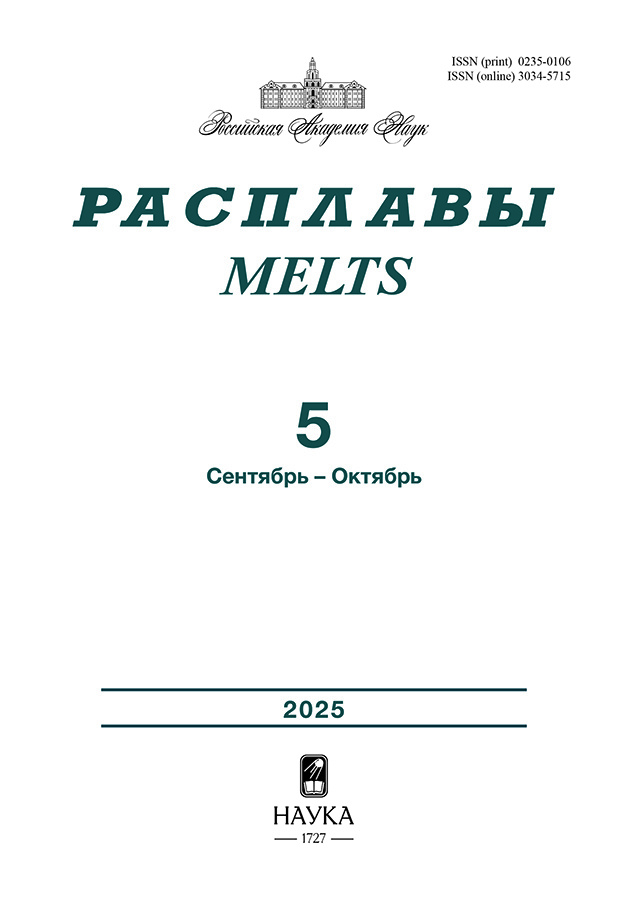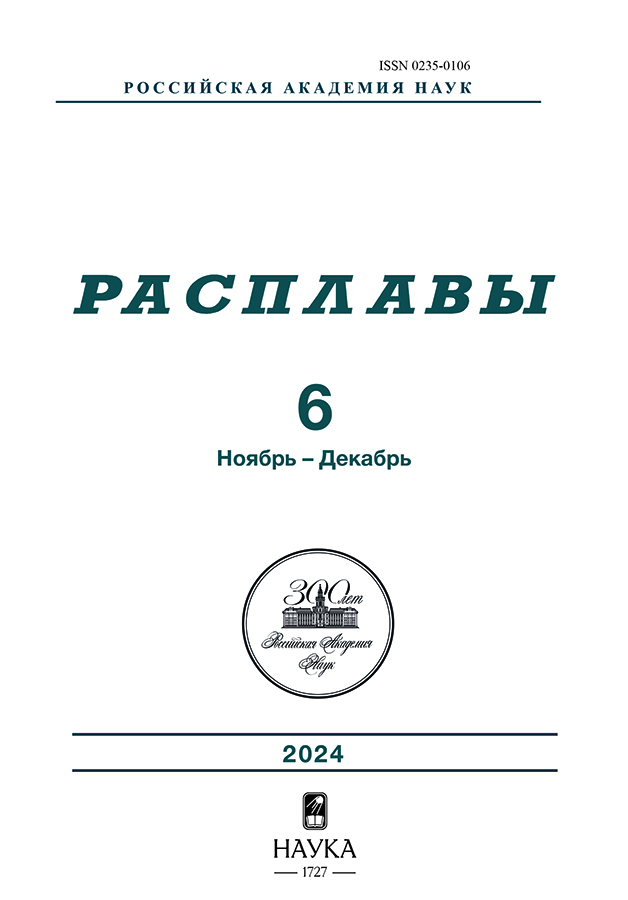№ 6 (2024)
Статьи
Коррозия стали ЭП-823 (16Х12МВСФБР) в условиях высокотемпературной обработки ОЯТ
Аннотация
Изучено коррозионное поведение стали ЭП-823 при высокотемпературной обработке (ВТО) азотом. Установлено, что в азоте при температурах 650–800°С сталь подвергается лишь незначительной поверхностной коррозии. Показано, что происходит незначительное изменение поверхностного состава и структуры стали, не оказывающее существенного влияния на процессы переработки модельного отработавшего ядерного топлива (ОЯТ). Показано, что на поверхности материала протекают процессы взаимодействия некоторых электроотрицательных компонентов ферритно-мартенситной стали с компонентами газовой фазы – азотом и примесным кислородом с образованием включений нитридных и оксидных соединений хрома и марганца различного стехиометрического состава. Процесс лимитируется диффузией этих компонентов из объема сплава на поверхность. Скорости коррозии стали ЭП-823 при температурах 650 и 800°С составили при 12 –часовой выдержке 0.104 и 0.241 мм/год, а при 84-часовой выдержке 0.013 и 0.02 мм/год соответственно. Характер разрушения поверхности образцов сплошной неравномерный, отчетливо наблюдается локализация коррозии на границах зерен стали, что связано с образованием вторичных фаз вдоль границ зерен. В процессе ВТО происходит значительная сенсибилизация стали, по границам зерен наблюдается цепочечное выделение вторичных фаз, что приводит к развитию межкристаллитной коррозии. Сделаны выводы об изменении структуры материала в ходе высокотемпературного воздействия и определен характер коррозионного поражения материала; на основании результатов рентгенофлуоресцентного анализа сделаны выводы о составе продуктов коррозии стали ЭП-823.
 581-595
581-595


Термическая стабильность и электрофизические свойства оксидных вольфрамовых бронз, полученных электролизом расплавов
Аннотация
Оксидные вольфрамовые бронзы (ОВБ) кубической, тетрагональной и гексагональной структуры электроосаждали из поливольфраматных расплавов 0.8Na2WO4–0.2WO3, 0.25Na2WO4–0.25K2WO4–0.5WO3 и 0.1K2WO4–0.55Li2WO4–0.35WO3 соответственно в гальваностатических условиях (катодная плотность тока 25 мА⋅см–2, длительность электролиза 20 мин) при 973 K. Синтезированные порошки ОВБ исследовали методами рентгеноструктурного анализа, лазерной дифракции и сканирующей электронной микроскопии с микрорентгеноспектральным анализом. Для определения верхней границы диапазона термической стабильности изучали фазовый состав порошков ОВБ со средним размером частиц 40–50 мкм после изотермической выдержки при 373–1173 K в течение 2 ч в атмосфере воздуха или аргона. Порошки ОВБ тетрагональной структуры дополнительно исследовали методом синхронного термического анализа. Электросопротивление спрессованных при 473 K образцов измеряли на воздухе на постоянном и переменном токе. Установлено, что наиболее стабильными являются ОВБ гексагональной структуры, изоструктурные K0.3WO3, фазовый состав которых не меняется до 773 K при термообработке на воздухе и остается постоянным во всем изученном диапазоне температур в инертной атмосфере. Порошки ОВБ тетрагональной структуры, изоструктурные K0.475WO3 и Na0.28WO3, стабильны до 1073 K в атмосфере аргона и частично окисляются на воздухе выше 673 K с образованием ОВБ с более низким содержанием щелочного металла, WO3 и Na2W2O7. Фазовый состав ОВБ кубической структуры, изоструктурных Na0.74WO3, стабилен до 673 K на воздухе и до 873 K в аргоне. Исследования электропроводности всех образцов свидетельствуют о смешанной ионно-электронной проводимости с преобладанием электронной составляющей. Значения удельной электропроводности при 298–573 K для образцов ОВБ тетрагональной, кубической и гексагональной структуры варьируются в пределах 0.035–0.051, 0.012–0.030 и 0.005–0.019 (Ом⋅см)–1 соответственно.
 596-608
596-608


Хлорированный графит как положительный электрод алюминий-ионных источников тока с электролитом 1-этил-3-метилимидазолхлорид/хлорид алюминия
Аннотация
В данной работе определен тип зависимости поляризации катода алюминий- ионного источника тока на основе хлорированного графита исходной марки ЕС-02 в низкотемпературном расплаве хлорида алюминия с 1-этил-3-метилимидазолхлоридом от геометрических характеристик электрода и плотности тока. Определено, что для хлорированного графитного материала величины поляризации немного снижены по сравнению с исходным нехлорированным графитом той же марки в аналогичном расплаве и составляют 25–50 мВ при 1 мА/см2, кроме того, на зависимости поляризации от плотности тока отсутствует излом между значениями 1 и 1.2 мА/см2, характеризующий предельную скорость токогенерирующей реакции на нехлорированном графите и выход к режиму предельного тока, что означает повышение скорости основного процесса на лимитирующем электроде в результате хлорирования. С помощью реперного эксперимента на стеклоуглеродном плоском электроде оценена плотность сорбции хлоралюминатных комплексов по поверхности хлорированного графита, которая для разных площадей электродов и плотностей тока составила величины около 15%. Соответственно, предельная степень интеркаляции для таких материалов равна 6. Поскольку хлорирование графита не приводит к искажениям геометрических параметров межслоевых щелей, установлено, что плотность сорбции хлоралюминат-ионов в результате хлорирования возрастает, в случае нехлорированного графита величина степени интеркаляции варьируется с плотностью тока от 9 до 18.
 609-623
609-623


Кластерная структура никеля и его сплавов с хромом в жидком состоянии
Аннотация
Рассмотрены современные представления о строении жидких металлов и сплавов. Основной акцент сделан на кластерной модели и ее структурных параметрах. Показано влияние концентрации хрома в никель-хромовых расплавах на изменение параметров кластерной структуры. На основе известных методик рассчитаны изменения энергии Гиббса и энергии межатомного взаимодействия при температуре 1600ºС для сплавов никеля с хромом. Определены параметры кластерной и межкластерной структуры изучаемых композиций, такие как радиус кластера, среднее количество атомов в кластере, количество кластеров в моле вещества, площади межкластерных разрывов и объем межкластерного пространства. Построены политермы, и изотермы рассчитанных параметров. Показано, что все изотермы демонстрируют изменение характера зависимости при 20–25 мас. % Cr, причем, с повышением температуры отмеченная особенность становится убедительнее. Результаты расчетов сопоставлены с ранее полученными экспериментальными рентгеноструктурными данными и результатами исследования температурных зависимостей физических свойств никеля и его сплавов с хромом в жидком состоянии. Обращено внимание на то, что при температуре близкой к 1900ºС радиус кластеров становится менее 10 Ǻ и именно такие значения имеют критические температуры, характерные для бинарных и многокомпонентных никелевых расплавов, при достижении которых происходят структурные изменения и металлическая жидкость становится более равновесной и микрооднородной. Таким образом, режим термовременной обработки, применяемый в процессе выплавки и назначаемый по результатам исследования физических свойств расплава необходимо связывать с температурой структурного превращения в жидкости, когда кластеры становятся наноразмерными.
 624-632
624-632


Исследование кинематической вязкости и удельного электросопротивления износостойких чугунов ИЧХ28Н2 и ИЧ300Х25Ф4 в жидком состоянии
Аннотация
Представлены результаты экспериментального исследования температурных зависимостей кинематической вязкости и удельного электросопротивления износостойких чугунов ИЧХ28Н2 и ИЧ300Х25Ф4 в жидком состоянии. Кинематическую вязкость определяли методом затухающих крутильных колебаний тигля с расплавом. Удельное электросопротивление измеряли методом вращающего магнитного поля. Измерения проведены в режиме двух последовательных нагревов образцов от 1300 до 1650 °C. После первого измерения образец кристаллизовали и охлаждали до температуры 25 °C со скоростью 1 °C/с. Второе измерение проводили без извлечения образца из лабораторной установки и изменения атмосферы. Результаты измерения температурных зависимостей кинематической вязкости и удельного электросопротивления обсуждаются в рамках представлений о микронеоднородном строении жидких чугунов. Обнаружен гистерезис температурных зависимостей вязкости и электросопротивления, полученных при первом нагреве образцов до 1550 °С, что служит косвенным свидетельством разрушения микронеоднородностей. Отсутствие гистерезиса при втором нагреве образца после кристаллизации подтверждает необратимый характер разрушения микронеоднородностей. Сделан вывод о рекомендованном режиме высокотемпературной обработки расплава (ВТОР) износостойких чугунов, предполагающем нагрев расплава до 1550 °С. Нагрев жидких износостойких чугунов ИЧХ28Н2 и ИЧ300Х25Ф4 до 1550 °С приводит к разрушению микронеоднородностей, вследствие чего при последующем охлаждении и кристаллизации формируется улучшенная микроструктура слитка.
 633-642
633-642


Кинетика электровосстановления фторцирконатов во фторидных расплавах
Аннотация
В настоящее время, существенно возрастает спрос на алюминиевые сплавы, в том числе с добавками циркония. Одним из способов производства таких сплавов является восстановление фторцирконатов щелочных и щелочноземельных металлов в расплавленных солях, данный метод характеризуется высокой степенью извлечения и интенсивностью процесса. Согласно данным научно-технической литературы, повышению эффективности подобных процессов может способствовать применение электролиза, в связи с чем актуальным является изучение электрохимического поведения фторцирконатов в расплавленных средах. Методом циклической хроновольтамперометрии изучены некоторые закономерности электровосстановления циркония и алюминия из легкоплавкого расплава KF–AlF3–Al2O3–ZrO2 при температуре 750°С, в зависимости от состава добавки и материала подложки. Были получены серии поляризационных кривых, как в чистом расплаве, так и с добавками фторцирконата калия, при скоростях развертки потенциала от 0.01 до 2 В. Показано, что катодные токи электровыделения алюминия появляются при потенциалах –1.6...–1.7 В, относительно потенциала CO/CO2 электрода, дальнейшее смещение потенциала в катодную область приводит к совместному выделению алюминия и калия. При введении K2ZrF6 в расплав KF-AlF3-Al2O3 на катодной ветви вольтамперограмм, появляются площадка разряда ионов циркония при потенциалах –1.4 и –1.6 В. При сравнении вольтамперограмм, полученных с добавками оксида циркония и фторцирконата калия при прочих равных условиях, было установлено, что при добавке оксида на катодной ветви вольтамперограмм наблюдается два перегиба при потенциалах –1.4 и –1.7 В, в то время как при восстановлении фторцирконата наблюдается лишь один перегиб при потенциале –1.3 В. Наличие двух откликов при введении оксида может быть вызвано как электровыделением элементарного циркония в две электрохимические стадии, так и разрядом цирконий-содержащих ионов разного состава. Анализ дифрактограмм расплавов показывает, что независимо от состава добавки, в расплаве могут присутствовать как фторцирконат калия, так и оксид циркония. Исходя из полученных данных, можно сделать вывод, что цирконий может либо разряжаться в несколько стадий, либо образовывать ряд промежуточных соединений при взаимодействии с компонентами расплава.
 643-652
643-652


Кинетика электровосстановления циркония на вольфраме во фторидных расплавах
Аннотация
Алюминиевые сплавы с добавками циркония находят все большее применение в аэрокосмической отрасли, приборостроении и энергетике, благодаря сочетанию повышенной коррозионной и термической стойкости без ущерба для плотности и электропроводности. Перспективным способом получения таких сплавов является синтез в расплавленных фторидах щелочных и щелочно земельных металлов, с использованием оксидов в качестве расходного металл-содержащего компонента. Согласно существующим научно-техническим данным, повышению эффективности восстановления оксида циркония до металлического может способствовать применение электролиза, в связи с чем, актуальным является изучение электрохимического поведения ионов циркония во фторидных расплавах. Методом циклической хроновольтамперометрии изучены основные закономерности катодного электровосстановления ионов циркония и алюминия из расплавов на основе KF–AlF3 с добавками оксидов циркония и алюминия при температуре 750°С, на вольфрамовом катоде. Были получены серии поляризационных кривых, как в чистом расплаве, так и с добавками оксидов циркония и алюминия, при скоростях развертки потенциала от 0,1 до 2 В. Показано, что разряд ионов алюминия наблюдается отрицательнее потенциала –1.6 В, а при потенциале от –1.8 до –1.9 В формируется пик Al соответствующий восстановлению ионов алюминия. В области потенциалов положительнее –1.6 В также отмечается катодный процесс AlxWy, предположительно связанный с восстановлением ионов алюминия и образованием его интерметаллидных соединений с вольфрамом. При добавлении ZrO2 в исследуемый расплав на вольтамперограммах дополнительно появляются площадка Zr и пик Al+Zr при потенциалах –1.3 и –1.6 В, связанные с разрядом ионов циркония и совместным разрядом ионов циркония и алюминия соответственно. При развертке потенциала в анодную область наблюдается пик Al’ при потенциале около –1.6 В и волны Al’ и Zr’, связанные с окислением металлического алюминия и алюминия с цирконием из интерметаллидного соединения, соответственно. Для вольфрамового электрода, ожидаемо наблюдается рост плотностей токов пика Al+Zr и смещение потенциала при повышении скорости развертки потенциала, что указывает на электрохимическую необратимость исследуемого процесса.
 653-662
653-662


Получение разбавленных растворов трихлоридов редкоземельных металлов хлорированием их оксидов в расплавленной эквимольной смеси NaCl-KCl
Аннотация
Статья посвящена исследованию и термодинамическому обоснованию метода получения разбавленных растворов трихлоридов редкоземельных металлов хлорированием их оксидов в расплавленной эквимольной смеси NaCl-KCl. Эффективность данного метода продемонстрирована на примере оксидов лантана (III) и неодима (III). Рассчитана свободная энергия Гиббса реакций хлорирования La2O3 и Nd2O3 различными хлорирующими агентами. Экспериментально изучено взаимодействие оксидов лантана (III) и неодима (III) в расплавленной эквимольной смеси NaCl-KCl в зависимости от времени хлорирования и материала реакционных сосудов (оксида бериллия и стеклоуглерода). Приведены результаты термодинамического моделирования реакций хлорирования La2O3 и Nd2O3 газообразным хлором в этом солевом расплаве. В случае использования расплавленной эквимольной смеси NaCl-KCl наблюдается значительное смещение энергии Гиббса в отрицательную область по сравнению с хлорированием без использования солевой среды. Эффективность хлора, как хлорирующего агента, в расплаве основана на том, что в жидком NaCl-KCl ионы Ln3+ образуют комплексы с малым коэффициентом активности. Увод синтезированного трихлорида лантана из зоны реакции хлорирования за счет его растворения в маловязком расплаве NaCl-KCl благоприятно сказывается на скорости протекания реакции хлорирования. Показано, что образование трихлоридов редкоземельных металлов идет через образование оксихлоридов LaOCl и NdOCl. Показаны преимущества предложенного метода хлорирования оксидов редкоземельных металлов (РЗМ) при синтезе растворов их трихлоридов в расплавленных солях.
 663-675
663-675


Растворимость оксидов редкоземельных элементов в хлоридных, хлоридно-фторидных и фторидных расплавах щелочных и щелочноземельных металлов
Аннотация
В данной работе представлен обзор данных по растворимости оксидов редкоземельных элементов в галогенидных расплавах щелочных и щелочноземельных металлов. Наибольшая растворимость оксидов редкоземельных элементов наблюдается во фторидных расплавах, наименьшая – в хлоридных. Работ, посвященных изучению растворимости оксидов редкоземельных элементов в смешанных хлоридно-фторидных расплавах, крайне мало. Растворимость оксидов редкоземельных элементов уменьшается в ряду La-Ce-Pr-Nd-Gd. Наибольшее количество работ посвящено изучению растворимости оксидов неодима, лантана и церия. Практически отсутствуют данные по растворимости «тяжелых» оксидов редкоземельных элементов (от Tb до Lu) в галогенидных расплавах.
 676-694
676-694


К юбилею Закирьяновой Ирины Дмитриевны
 695-696
695-696


Памяти Красикова С.А.
 697-698
697-698













